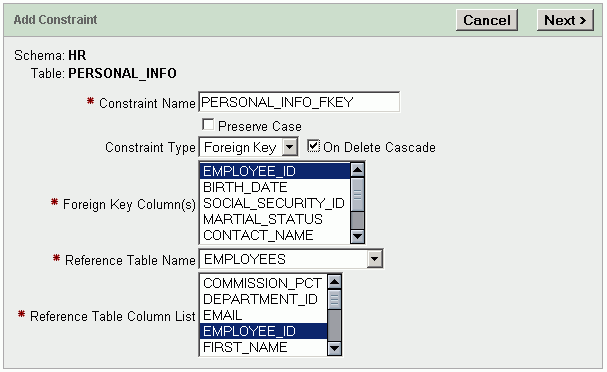
To prevent the appearance of duplicated values, the PRIMARY KEY constraint also enforces the properties of the NOT NULL constraint.įor best practices, see Schema Design: Select primary key columns. Foreign keys are added into an existing table using the ALTER TABLE statement. Normally, a foreign key in one table points to a primary key on the other table. However, because NULL values never equal other NULL values, the UNIQUE constraint is not enough (two rows can appear the same if one of the values is NULL). Foreign key refers to a field or a set of fields in a table that uniquely identifies another row in another table.

The properties of the UNIQUE constraint ensure that each value is distinct from all other values. A foreign key with a cascade delete can be defined in either a CREATE TABLE statement or an ALTER TABLE statement. This is called a cascade delete in Oracle. The properties of both constraints are necessary to make sure each row's primary key columns contain distinct sets of values. A foreign key with cascade delete means that if a record in the parent table is deleted, then the corresponding records in the child table will automatically be deleted. To ensure each row has a unique identifier, the PRIMARY KEY constraint combines the properties of both the UNIQUE and NOT NULL constraints. I tried to create foreign key after sync in msql: SQL> alter table test2 add. For more information, see our blog post SQL in CockroachDB: Mapping Table Data to Key-Value Storage. Creating a foreign key constraint (Oracle Apex 3.2) - Oracle Application. This index does not take up additional disk space (unlike secondary indexes, which do) because CockroachDB uses the primary index to structure the table's data in the key-value layer. The columns in the PRIMARY KEY constraint are used to create its primary index, which CockroachDB uses by default to access the table's data.


CREATE TABLE IF NOT EXISTS inventories ( product_id INT, warehouse_id INT, quantity_on_hand INT NOT NULL, PRIMARY KEY ( product_id, warehouse_id ) ) Details


 0 kommentar(er)
0 kommentar(er)
